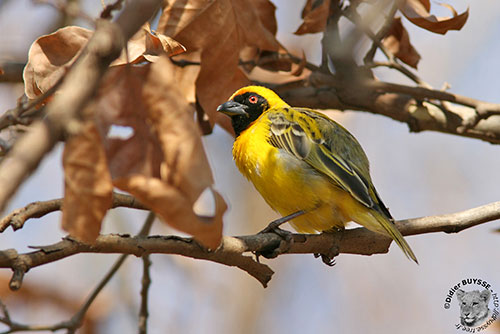
TO BE CONTINUED... SECOND PART
Text by Nicole Bouglouan
Photographers:
John Anderson
John Anderson Photo Galleries
Didier Buysse
Vision d’Oiseaux
Callie de Wet
GALLERY
Jean Michel Fenerole
Photos d’Oiseaux du monde
Steve Garvie
RAINBIRDER Photo galleries
Jean-Claude Jamoulle
A la rencontre des Oiseaux
Ken Havard
My Bird Gallery & Flickr gallery 1 & Flickr gallery 2
Tom Merigan
Tom Merigan’s Photo Galleries
William Price
PBase-tereksandpiper & Flickr William Price
Dubi Shapiro
Dubi Shapiro Photo Galleries
Stapelberg Philip
GALLERY
Simon Tan
PBase Bird galleries
Sources:
HANDBOOK OF THE BIRDS OF THE WORLD Vol 15 by Josep del Hoyo-Andrew Elliot-David Christie - Lynx Edicions – ISBN: 9788496553682
ROBERTS BIRDS OF SOUTH AFRICA by G. R. Mc Lachlan and R. Liversidge – The Trustees of the John Voelcker Bird Book Fund – ISBN: 0620031182
The Birds of Africa: Volume VII – C. Hilary Fry, Stuart Keith – Editeur: Bloomsbury Publishing, 2020 – ISBN: 1472986563, 9781472986566 – 724 pages
The Birds of Africa: Volume VIII: The Malagasy Region: Madagascar, Seychelles, Comoros, Mascarenes - Par Roger Safford, Frank Hawkins – ISBN: 1408190494, 9781408190494- Editeur: A&C Black, 2013
CREAGUS@Monterey Bay (Don Roberson)
SORA - WEAVERBIRD NEST AGGREGATION AND EVOLUTION OF THE COMPOUND NEST
Repeatability of nest morphology in African weaver birds
11 Interesting Facts about Sociable Weavers
Weaver Watch - Monitoring the Weavers of the World
Fatbirder - The World’s Richest Information Resource about Birds for Birders
Wikipedia, the free encyclopaedia
FAMILY PLOCEIDAE (First part)
Weavers, sparrow-weavers, bishops, widowbirds, fodies, malimbes, queleas …
The family Ploceidae includes small, finch-like birds, closely related to the family Fringillidae. They are native of the Old World and are mostly found in Africa south of the Sahara, some species are present on the Indian Ocean islands, but a small part of this large family also lives in tropical areas of Asia.
In Africa, they are usually found in wetlands and rainforest but also at the arid edges of the true deserts. In Asia, they are restricted to grassland and savanna areas. They feed primarily on seeds, insects and nectar from flowers.
During the breeding season, numerous species breed along rivers or lakes, whereas they prefer savannas and steppes outside of nesting period.

Southern Masked Weaver
Ploceus velatus
The weavers owe their name to the way they build their nest. Numerous nesting structures are elaborate and complex, with a completely enclosed chamber made with interwoven vegetal materials such as grass, leaves, roots, twigs and others. The male builds the nest at the beginning of the breeding season, and uses it to attract a mate. If a female approves the basic structure, she may help the male to complete the nest. The nest-site is well chosen, in order to protect the chicks.
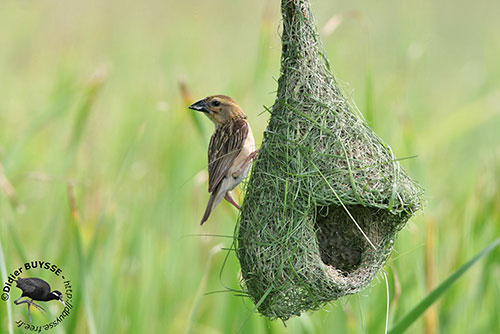
Baya Weaver
Ploceus philippinus
The members of the family Ploceidae are mainly residents and some movements are probably related to food availability.
Many species are widespread and abundant in both natural and human-modified habitats. But more specialized species have very restricted range. Island species are vulnerable, due to habitat destruction and introduced predators, although these predators are now controlled in several islands. Generally, habitat destruction is the main threat for numerous species, but pet trade and persecution as pest of cultivated areas are also important problems for these beautiful birds.
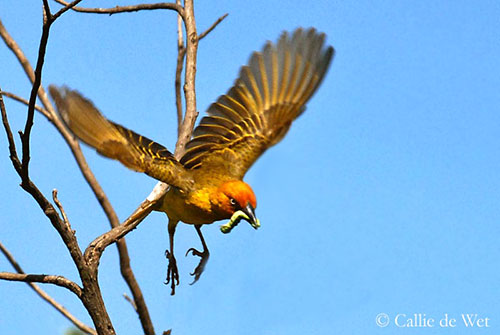
Ploceus capensis
The weavers are fairly small, with a length ranging from 11 to 25 centimetres and a weight of 10 to 85 grams.
The Slender-billed Weaver weighs about 10 grams, whereas the White-headed Buffalo-Weaver is about 85 grams.
The males are usually brightly-coloured with red, yellow, orange, chestnut, black and white contrasting patches, some of them only during the breeding season. The females are much duller. The conspicuous plumage of the males is exposed during the courtship displays.
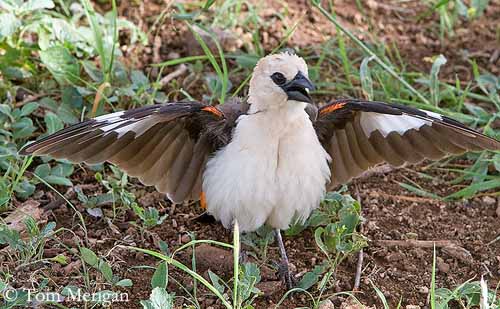
Dinemellia dinemelli
However, in one species, the Compact Weaver, both mates have a very distinctive nuptial plumage. During this period, the female shows a contrasting black and yellow head with black mask and crown, while the male has yellow head with chestnut forehead and black mask.
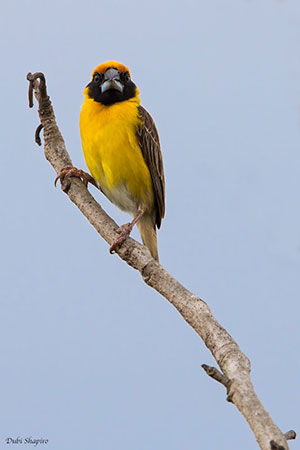
Compact Weaver male
Ploceus superciliosus
After breeding, several species are moulting and the males become very similar to the females which do not change colour or become only slightly paler than in breeding period. The juveniles usually resemble female.
The bill is short, massive, strong and conical, like a typical finch-bill. The colour of the eyes is very variable depending on the species. The legs are short, but some species have large feet.
The weavers of Africa south of the Sahara are present from sea-level to forests and grasslands at high elevations. They frequent wetlands and rainforest but they also occur in arid areas at the edges of the true deserts.
The five Asian species are restricted to grasslands and savannas.
Some seasonal changes are observed during the breeding season, with suitable habitats for nest-building. Outside of this period, the birds may range through very different zones within the same biome.
The resident weavers of the Indian Ocean islands have more limited range of suitable habitats. Some of them such as the Seychelles Fody have adapted to other habitat types such as coconut plantations and gardens.
On the other hand, the Sakalava Weaver frequents habitats cleared by human settlement, cultivations and regrowth, in addition to its usual habitats.
The Mauritius Fody frequents several types of forest, included degraded woodland invaded by exotic plant species. They are numerous in small plantations surrounded by remnants of native forest.
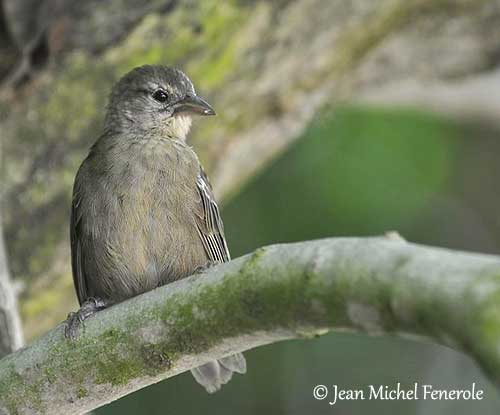
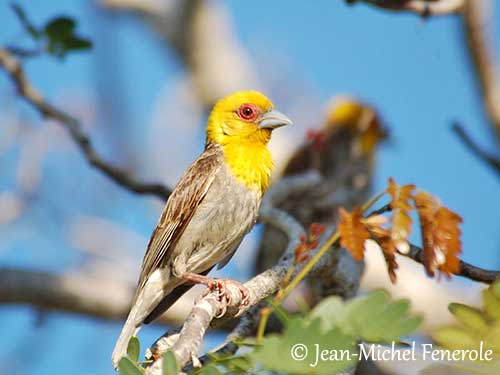
Ploceus sakalava
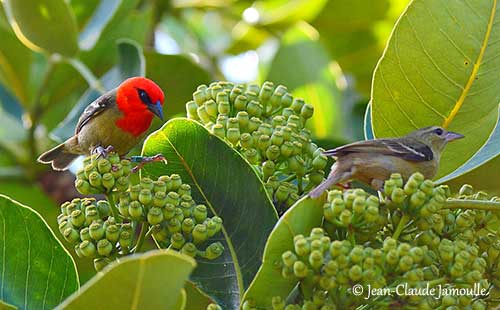
Generally, all weavers depend on supporting structures for their nests. In arid regions with little ground cover, they use scattered trees for nest-sites. In these habitats, the nests are also used as roosting sites by several species. The protection provided by the nests is very important in winter, when temperatures fall below freezing at night in locations such as the Kalahari Desert in Southern Africa.
For example, the Scaly-feathered Weaver that weighs about 12 grams is present in this type of habitat with frosty nights. For this species which roosts communally, a covered nest shared with other warm bodies is crucial.
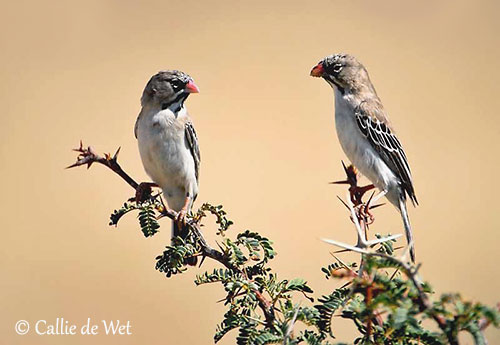
Scaly-feathered Weaver
Sporopipes squamifrons
The weavers feed primarily on seeds and arthropods, but they could be considered omnivorous because they take a wide range of animal food such as small vertebrates, fruit and other vegetable food items. The young are usually fed largely on insects during the first days, even when adults are granivorous.
A seasonal difference exists, and some granivorous species often join mixed-species flocks of insectivores in the woodlands of Africa during the dry season.
Numerous weavers also take nectar in Africa, especially from Aloe which provides flowers in winter when other food items are not available.
In South Africa, both Cape Weaver and Village Weaver feed on pollen at flowers of Strelitzia regina and are the main agents of pollination for this plant.
A unique example in this large family is the Seychelles Fody which feeds on the eggs of white-eyes (Zosteropidae) and small terns (Laridae).
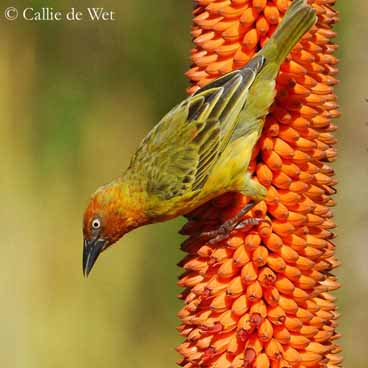
Ploceus capensis
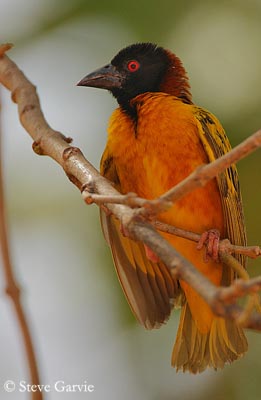
Village Weaver - Ploceus cucullatus
Race Ploceus cucullatus spilonotus (left)
Both size and shape of the bill provide information on the part of the seeds in the diet of a species. The Thick-billed Weaver (or Grosbeak Weaver) is able to crack sunflowers seeds, but it also catches insects on the wing to feed the young. From some observations, it has been observed eating small frogs too.
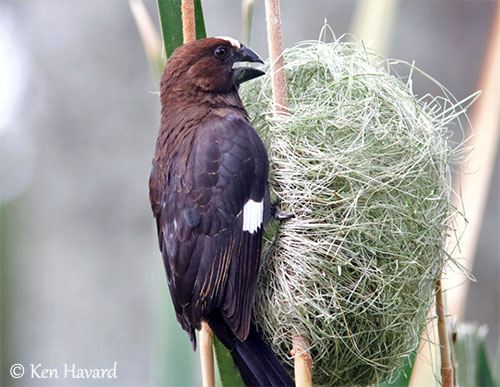
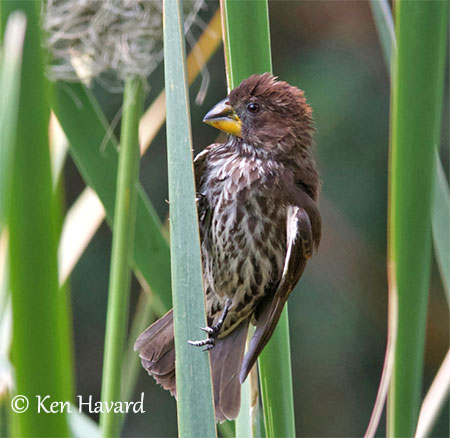
The Little Weaver and the Slender-billed Weaver weigh about 12-14 grams and have very similar plumage. But the bill of the latter is longer and much more slender, well-adapted for gleaning insects from foliage like a white-eye. On the other hand, the Little Weaver has shorter, thicker bill and feeds mostly on many seeds from various plant species.
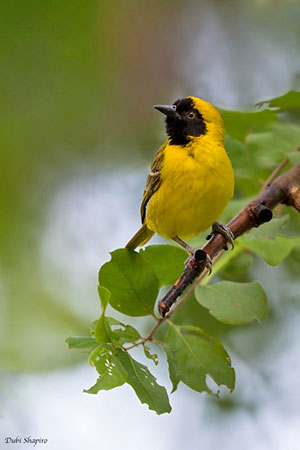
Little Weaver
Ploceus luteolus
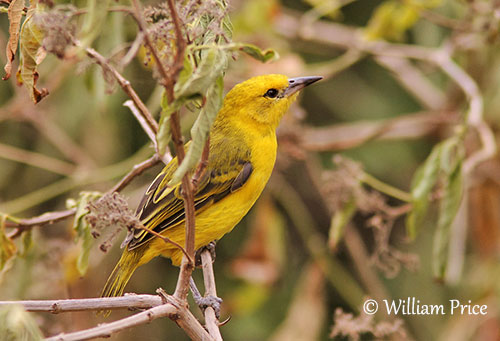
Slender-billed Weaver
Ploceus pelzelni
Many weavers are able to hawk flying insects. The Southern Red Bishop catches dragonflies over the water to feed its young in the nest at the breeding colony.
The insect-eater weavers forage in trees by probing bark crevices on both tree trunks and branches, always working upwards. They are very agile and often hang upside-down while searching for prey such as concealed insects, insect eggs and larvae. With their strong bill, they can tear off flakes of bark to expose insects and arthropods living beneath.
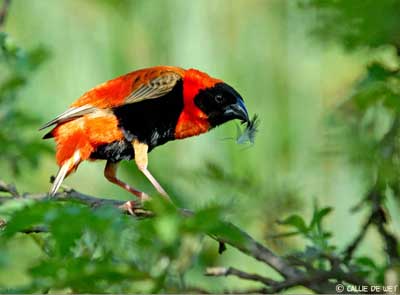
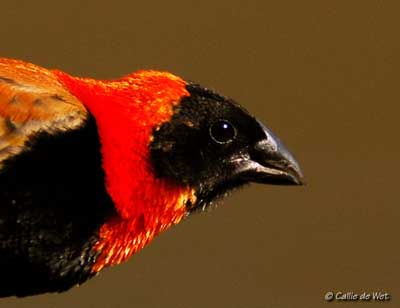
Weavers often join mixed-species feeding flocks, in order to benefit of better security from predators. In addition, foraging in flock allows to disturb many concealed insects involving better foraging success.
The Red-collared Widowbird frequently forages close to or on the ground, searching for seeds, beetles, ants, caterpillars and termites. The feeding flocks may include 50-100 birds, including males in breeding plumage. In this species, the male does not take part in chick-feeding.
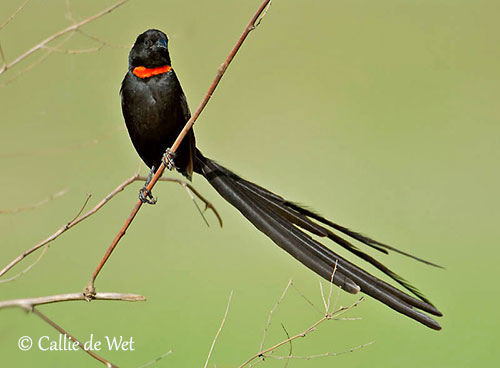
Red-collared Widowbird
Euplectes ardens
The weavers are not solitary birds. Outside of breeding season, both monogamous and colonial Ploceidae feed in flocks of various size and roost communally, sometimes with other species such as starlings. These roosts are often over water in reedbeds where the temperature drops rapidly at night during the winter.
The roosts of the Red-billed Quelea may hold hundreds, thousands or millions of individuals. Protection, rather than thermal regulation, is the major concern for the birds.
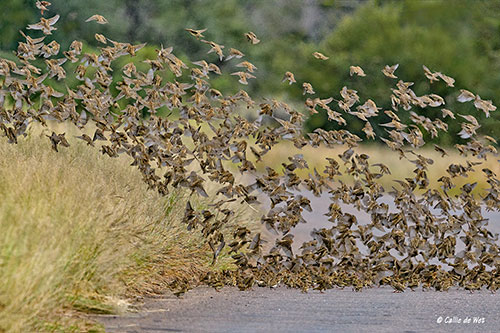
Red-billed Quelea
Quelea quelea
The Ploceidae are not very good songsters. The colonial breeding males sing during the displays, but the song is described as a harsh, repetitive chatter. They spend a considerable amount of time to vocalize, but their visual displays are much more appreciated, due to their bright-coloured plumages. The females seem to be silent.
Both mates of Dark-backed Weaver species remain together all year round and for several breeding seasons. They perform a musical duet during which the two partners sing simultaneously. Local dialects can be heard and large differences between populations are evident. These observations suggest that the young birds learn the songs while being still in family groups with their parents.
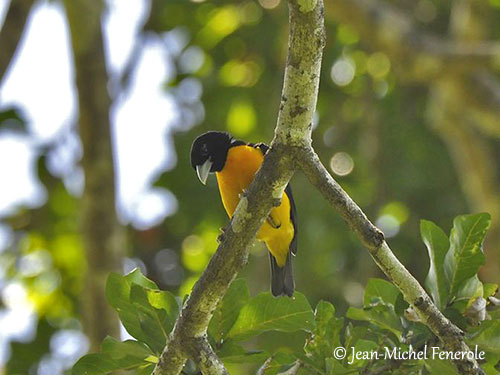
Dark-backed Weaver
Ploceus bicolor
Like numerous species, the weavers sing during the breeding season to advertise the territory and to defend the nest-site. The songs are given from exposed perches or at nest-entrance.
Several members of a group may sing together, often a short song, during territorial defence when an intruder is approaching during the day. In this case, the birds may sing while perched side by side, from the ground or from elevated perches.
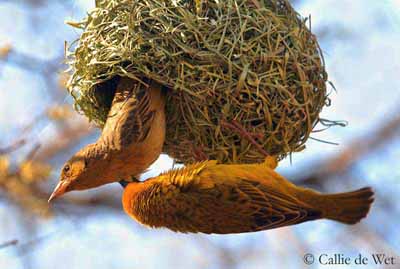
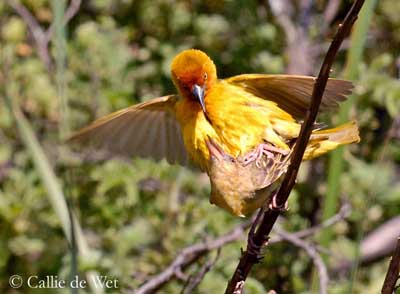
Cape Weaver - Ploceus capensis
The weavers can be either monogamous or polygamous, and highly colonial to solitary.
About half of the species of genus Ploceus is colonial, but they form relatively small aggregations of a dozen to a few hundred nests. The Village Weaver is highly colonial, and we can find more than 200 nests in a single tree, and some colonies may reach up to 1000 nests. It may breed in mixed colonies with other weaver species.
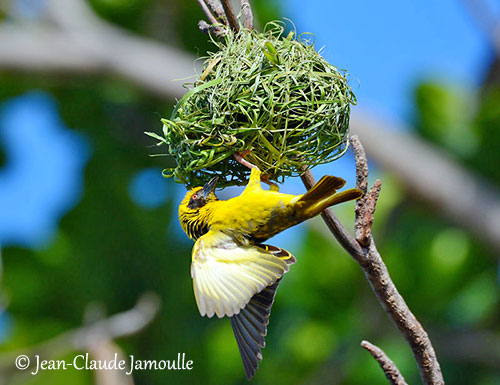
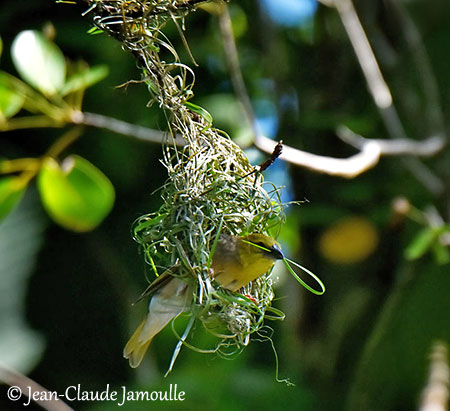
Ploceus cucullatus
Ploceus cucullatus
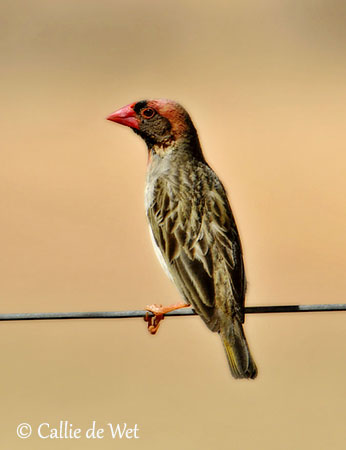
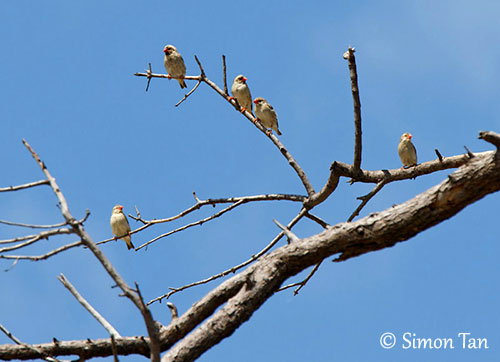
Red-billed Quelea
Quelea quelea
Red-billed Quelea
Quelea quelea
At the other extreme, numerous species such as the fodies, most of the bishops and widowbirds, and most of the malimbes are solitary nesters.
The Jackson’s Widowbird breeds solitary, but several nests are often clustered with up to 20 through a small area.
The males form leks where they display on separate circles of flattened grass around a central tuft worked and shaped by the male.
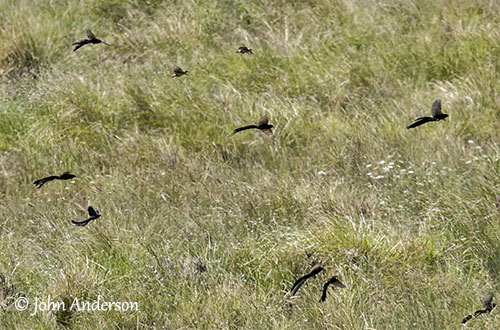
Jackson’s Widowbird
Euplectes jacksoni
Flying to the lek
While displaying, it jumps up to 1 metre above the ground, with the head thrown back. The neck feathers are fluffed out and the tail is arched forwards until to touch the back of the head.
The females start to visit the lek, and when one of them lands into a circle, the owner male displays on the ground. Crown and nape feathers are erected as a visual signal to other males.
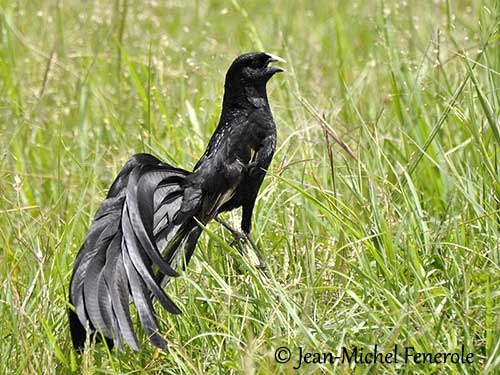
Jackson’s Widowbird
Euplectes jacksoni
From studies and some observations, habitat, feeding habits and breeding dispersal play a role. The granivores living in savannas are typically colonial and polygynous, whereas insect-eaters living in forest are solitary and monogamous, with some exceptions of course.
Various studies show three types of male displays.
Some males chase and approach the female, often far from the nest. This behaviour is then followed by nest-invitation display.
Another display shows the female attracted to male displays centred on the nest, also followed by nest-invitation.
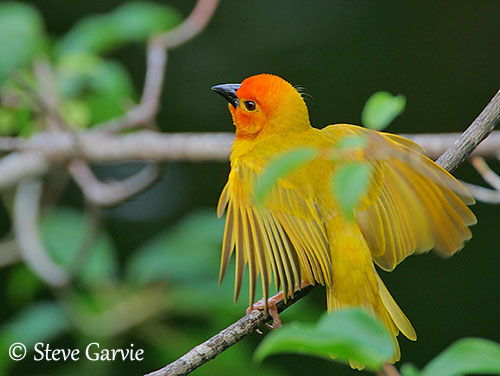
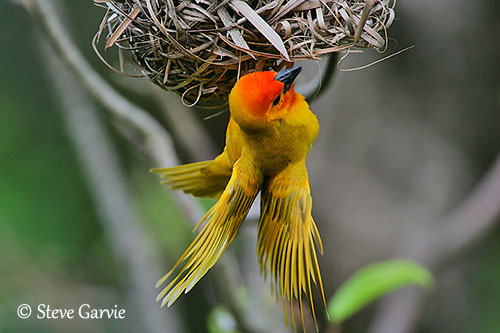
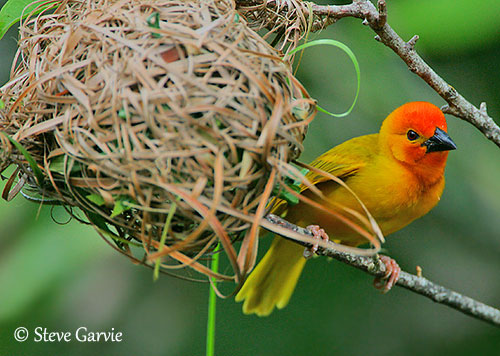
Golden Palm Weaver
Ploceus bojeri
Golden Palm Weaver
Ploceus bojeri
Golden Palm Weaver
Ploceus bojeri
Other males perform aerial displays over the territory to attract the female, followed by perched courtship within the territory.
The bright-coloured plumages of the males are enhanced and exposed by adapted postures and movements. The visual displays are closely related to the distinctive plumages of the males. Some species of genus Ploceus may have different courtship displays and behaviour.
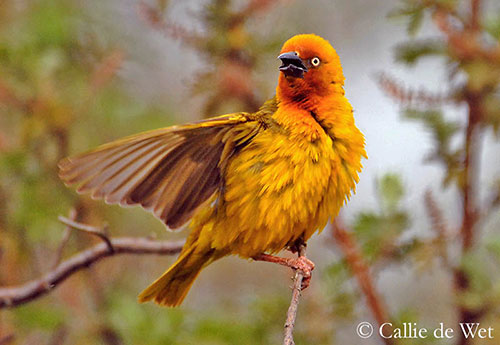
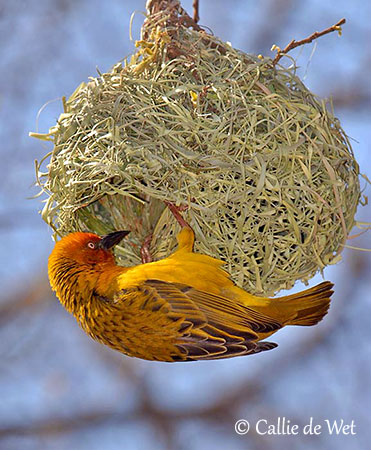
Ploceus capensis
Ploceus capensis
For all species of this family, the nest is the central element of the social organization. When a new colony is established, the nest-building by the future breeding pair forms the first part of their courtship. The nests of the family Ploceidae are very different depending on the genus.
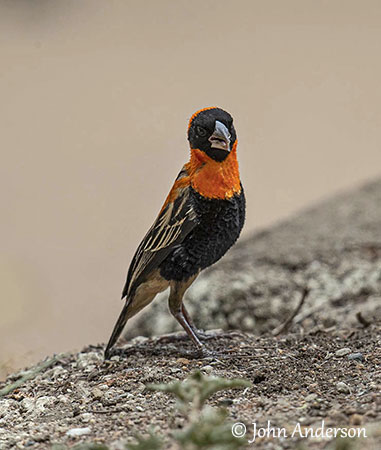
Black Bishop
Euplectes gierowii
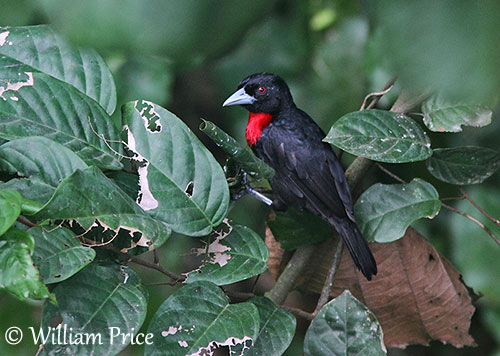
Blue-billed Malimbe
Malimbus nitens
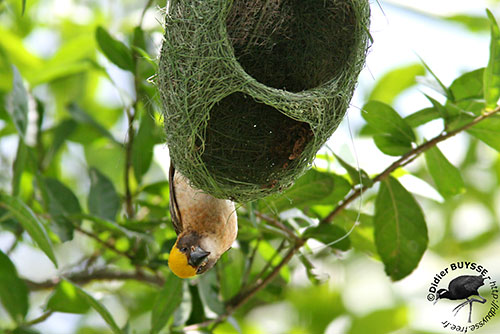
Baya Weaver
Ploceus philippinus
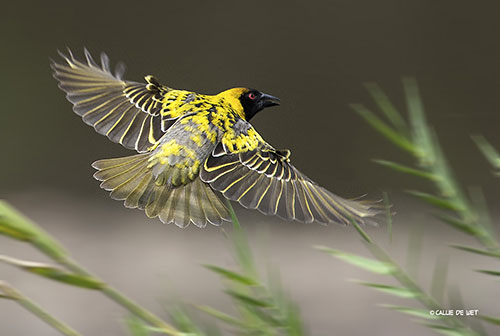
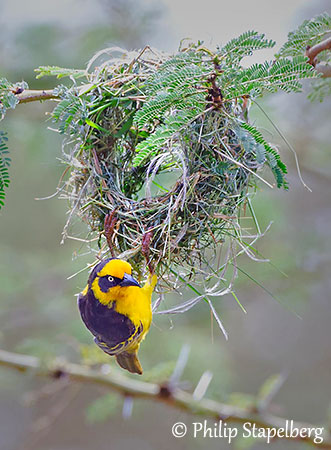
Ploceus baglafecht